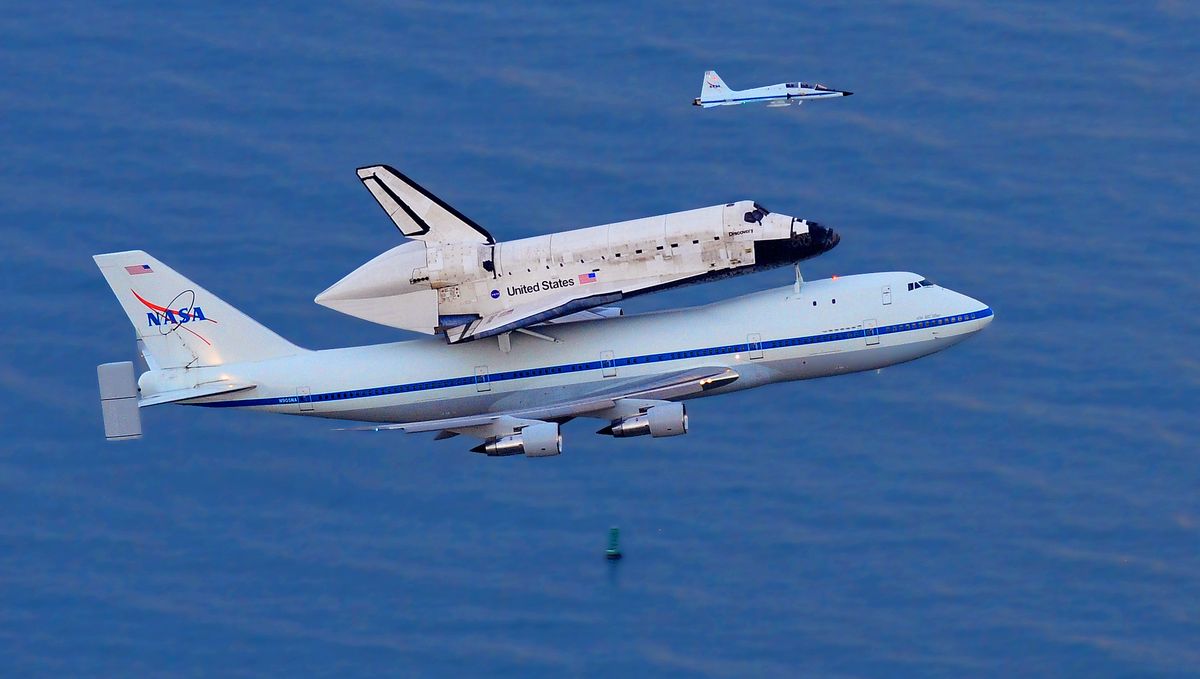Shuttle hitches final ride to its new home

CHANTILLY, Va. – The space shuttle Discovery went out in high-flying style.
After three spectacular spins above the nation’s capital, the world’s most traveled spaceship completed its final flight and was ready to become a grounded museum relic.
But what an exit. Discovery took victory laps around the White House, the Capitol and the Washington Monument that elicited cheers and awe – the same sounds and emotions that used to accompany every thunderous launch.
Bolted to the top of a modified 747 jumbo jet, the shuttle took off at daybreak Tuesday from Cape Canaveral, Fla. Three hours later, the combo took a few final swoops around Washington at an easy-to-spot 1,500-foot altitude.
“It was pretty amazing,” said 12-year-old Riley Jacobsen of Bethesda, Md. “Pretty freaking crazy. It looked like it was inflated.”
Sorena Sorenson, a geology curator for the Smithsonian Institution, was among thousands watching from the National Mall. For 43 years, she has carried an Apollo 11 medal on her keychain.
“This to me is just so bittersweet,” she said.
People filled the Capitol balcony and stood on rooftops to catch a glimpse of Discovery as it circled three times through partly cloudy skies. Construction workers staked out prime viewing spots on cranes.
The nostalgia extended to the crew at the controls of the 747. “The sad part is we’re retiring a very well-oiled machine,” pilot Bill Rieke said.
After landing at Dulles International Airport in northern Virginia, the shuttle will undergo final preparations to go on display Thursday at the Smithsonian’s National Air and Space Museum annex near the airport.
“We pledge to take care of her forever,” said retired Gen. John R. Dailey, the museum’s director. The shuttle will show young visitors “what America is capable of.”
John Porcari, 13, came out to Dulles because his dad is an administrator with the Transportation Department. He said he was blown away by Discovery’s size when it landed.
“It’s huge,” he said. “That’s something you don’t realize from seeing pictures.”
The landing “was just unbelievable,” said John, who would like to work in the space program someday. “This is history right here.”
NASA ended the shuttle program last summer after a 30-year run to focus on destinations beyond low-Earth orbit. Discovery – the fleet leader with 39 orbital missions – is the first of the three retired shuttles to be turned over to a museum. It first launched in 1984.
Terri and Bill Jacobsen used the flyover as a teaching experience for Riley, their son. They calculated the speed and angle at which the shuttle and plane would bank, plus other factors, to determine the perfect viewing spot. “Oh, my God, look at that,” Terri Jacobsen said as the shuttle appeared. “That thing is mammoth.”
Harold and Theresa Banks of Washington have watched many historic events on the mall since 1958: the inauguration and funeral of John F. Kennedy, Martin Luther King Jr.’s March on Washington, the Million Man March and Barack Obama’s inauguration. Discovery’s flight ranks high up with those events, they said.
Discovery’s list of achievements include delivering the Hubble Space Telescope to orbit, carrying the first Russian cosmonaut to launch on a U.S. spaceship, performing the first rendezvous with the Russian space station Mir with the first female shuttle pilot in the cockpit, returning Mercury astronaut John Glenn to orbit and resuming shuttle flights after the Challenger and Columbia accidents.
At the Smithsonian annex, Discovery will take the place of the shuttle prototype Enterprise. The Enterprise will go to New York City. Endeavour will head to Los Angeles this fall. Atlantis will remain at Kennedy.
With the shuttles grounded, private U.S. companies hope to pick up the slack, beginning with space station cargo and then, hopefully, astronauts. The first commercial cargo run, by Space Exploration Technologies Corp., is set to take place in a few weeks.
For at least the next three to five years – until commercial passenger craft are available in the United States – NASA astronauts will have to hitch rides aboard Russian Soyuz capsules to get to the International Space Station.